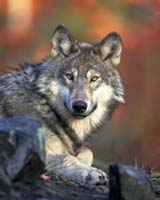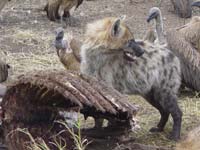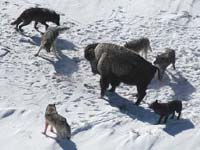
![]() Being confronted with a pack of wolves is bad enough, but if you happened to be in Alaska some 12,000 years ago, things would be much, much worse. Back then, the icy forests were patrolled by a sort of super-wolf. Larger and stronger than the modern gray wolf, this beast had bigger teeth and more powerful jaws, built to kill very large prey.
Being confronted with a pack of wolves is bad enough, but if you happened to be in Alaska some 12,000 years ago, things would be much, much worse. Back then, the icy forests were patrolled by a sort of super-wolf. Larger and stronger than the modern gray wolf, this beast had bigger teeth and more powerful jaws, built to kill very large prey.
 This uber-wolf was discovered by Jennifer Leonard and colleagues from the University of California, Los Angeles. The group were studying the remains of ancient gray wolves, frozen in permafrost in eastern Beringia, a region that includes Alaska and northwest Canada. These freezer-like conditions preserved the bodies very well, and the team found themselves in a unique position. They could not only analyse the bones of an extinct species, but they could extract DNA from said bones, and study its genes too.
This uber-wolf was discovered by Jennifer Leonard and colleagues from the University of California, Los Angeles. The group were studying the remains of ancient gray wolves, frozen in permafrost in eastern Beringia, a region that includes Alaska and northwest Canada. These freezer-like conditions preserved the bodies very well, and the team found themselves in a unique position. They could not only analyse the bones of an extinct species, but they could extract DNA from said bones, and study its genes too.
For their first surprise, they found that these ancient wolves were genetically distinct from modern ones. They analysed mitochondrial DNA from 20 ancient wolves and none of them was a match for over 400 modern individuals. Today's wolves are clearly not descendants of these prehistoric ones, which must have died out completely. The two groups shared a common ancestor, but lie on two separate and diverging branches on the evolutionary tree.
The genes were not the only differences that Leonard found. When she analysed the skulls of the Beringian wolves, she found that their heads were shorter and broader. Their jaws were deeper than usual and were filled with very large carnassials, the large meat-shearing teeth that characterise dogs, cats and other carnivores (the group, not meat-eaters in general).
This was the skull of a hypercarnivore, adapted to eat only meat and to kill prey much larger than itself using bites of tremendous force. Leonard even suggests that the mighty mammoths may have been on their menu.
 Once prey was dismembered, the wolves would have left no bones to waste. With its large jaws, it could crush the bones of recent kills, or scavenge in times between hunts. Today, spotted hyenas lead a similar lifestyle. The wolves' teeth also suggest that bone-crushing was par for the course. The teeth of almost all the specimens showed significant wear and tear, and fractures were very common.
Once prey was dismembered, the wolves would have left no bones to waste. With its large jaws, it could crush the bones of recent kills, or scavenge in times between hunts. Today, spotted hyenas lead a similar lifestyle. The wolves' teeth also suggest that bone-crushing was par for the course. The teeth of almost all the specimens showed significant wear and tear, and fractures were very common.
Their powerful jaws allowed the Beringian wolves to quickly gobble down carcasses, bones and all, before having to fend off the competition. And back then, the competition included many other fearsome and powerful hunters, including the American lion and the short-faced bear, the largest bear to have ever lived.
Leonard suggests that the ancestor of today's gray wolf reached the New World by crossing the Bering land bridge from Asia to Alaska. There, it found a role as a middle-sized hunter, sandwiched between a smaller species, the coyote, and a larger one, the dire wolf. When the large dire wolves died out, the gray wolf split into two groups. One filled the evolutionary gap left behind by the large predators by evolved stronger skulls and teeth. The other carried on in the 'slender and fast' mold.
 But in evolution, the price of specialisation is vulnerability to extinction. When its large prey animals vanished in the Ice Age, so too did the large bone-crushing gray wolf. Its smaller and more generalised cousin, with its more varied diet, lived to hunt another day.
But in evolution, the price of specialisation is vulnerability to extinction. When its large prey animals vanished in the Ice Age, so too did the large bone-crushing gray wolf. Its smaller and more generalised cousin, with its more varied diet, lived to hunt another day.
Similar things happened in other groups of meat-eaters. The American lion and sabre-toothed cats went extinct, but the more adaptable puma and bobcat lived on. The massive short-faced bear disappeared, while the smaller and more opportunistic brown and black bears survived. Leonard's findings suggests that the casualties of the last Ice Age extinction were more numerous than previously thought. What other predators still remain to be found in the permafrost?
Reference: Leonard, Vila, Fox-Dobbs, Koch. Wayne & van Valkenburgh. 2007. Megafaunal extinctions and the disappearance of a specialized wolf ecomorph. Curr Biol doi:10.1016/j.cub.2007.05.072
More on extinct genes and proteins:

Interesting. It begs the question though, what happened to the Dire Wolves if it wasn't the disappearance of the herbivorous megafauna? I.e. if there was still niche space for a big stocky wolf why did the giant bone-crushing coyotes (Dire Wolves) go extinct and leave a space for the Beringia wolf? Maybe the ranges didn't overlap at the same time?
The Dire Wolf was a native species. The other wolves were not. In some parts of the world where non-native species have been introduced they bring diseases, (squirrel pox in Europe, also a crayfish virus), which threaten the continuation of native species.
A possible reason for extinction?
Very interesting. I can just imagine that landscape with the wolves and other predators that are now extinct.
Thanks for reposting this, Ed. I think this was the first NERS post I ever read, back in the Wordpress days!
Leonard may be the first to suggest that the ancestor to today's modern gray wolves also led to a regional ecomorph in Alaska that was different from modern gray wolves -- but she is certainly not the first to suggest that the common ancestor for N. American wolves (likely C. mosbachensis according to Nowak) came across the land bridge from Asia. Look all the way back to the late 60s and 70s for that idea. Nowak delineates a good case for several biological expansions of early wolves from Asia to N. America, an early version of which likely resulted in C. rufus, with subsequent colonizations and speciation resulting in C. lupus (he traces both back to C. mosbachensis).
It's a Canis version of borophagines! I love those bone-crushing wolves. Great post, Ed.
It looks like asian *Canis* diversified tremendously when they went back to their ancestral homeland. Grey wolves *C. Lupus*, Red wolves *C. rufus*, Coyotes *C. latrans* and Eastern wolves *C. Lycaon*.
And now we have these very unusual Beringian "Grey Wolves".
What a wonderful taxonomic mess! Not to mention the differing placements of *C. dirus*.
Why hasn't anyone asked the obvious? Why aren't we trying to clone this thing? It would be awesome.
Very interesting!
I have long been interested in to Wolves but have never heard of a Super Wolf!
In response to Swintah...don't you think cloning it would be slightly dangerous? And also quite possibly selfish as it might not survive in this new world.
Furthermore, would you like to be the person/s responsible for bringing something into this world that could potentially bring disease and or massacre?
Species which are extinct are like that for a reason...leave things alone.